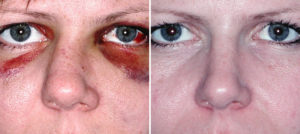Background: The nose is the most frequently fractured bone on the face. This is undoubtably because it is a very projecting structure that makes it easier to hit than other more recessed areas of the face. Even though the nose is two-thirds cartilage in composition, the small bones in the upper nose are highly prone to fracture with trauma.
While the nose can be struck from any angle, the most common cause of nasal fractures is from a side blow. The nasal bones are most frequently displaced in a lateral or side direction. Structurally this is the easiest direction for them to be displaced but also because most people turn their head to get away from the incoming force…resulting in the nose being struck from the side.
The treatment of most nasal fractures is often done acutely in the emergency room by closed reduction or delayed until a specialist is seen days to weeks later. The technique most commonly used is a closed reduction where instruments are used to push the bones back in place in a blind fashion. This can be a very successful procedure provided that the nasal derangement is not complex and involves substantial displacement of other structures such as the septum.
Case Study: This 28 year-old female was struck on the face and seen three days later with swollen and bruised eyes and an obviously deviated nose. The deflection of her nose to the right side of her nose demonstrated that the blow to her face came from the left side and probably from a right-handed assailant.
Two weeks later when most of the swelling had subsided, she underwent a closed reduction relocation of her nasal bones and an open reduction of her dislocated septum. The inwardly displaced nasal bone was moved back outward while the outwardly displaced right nasal bone was moved back inward. Through an internal hemitransfixion incision the fractured and displaced septum was removed, put back together to a resorbable PDS plate and then put back in the midline.

Repair of nasal fractures is often perceived as simple but that is only so if only nasal bone is displaced. Once both right and left nasal bones are displaced the internal septal cartilage by definition is also fractured and malaligned. Treatment of such nasal fractures requires management of the septum as well as the nasal bones to get the best nasal alignment and function after repair.
Highlights:
1) Nasal bone fractures are common and usually treated by closed reduction techniques.
2) The timing of nasal fractures depends on specialist evaluation and the degree of nasal injury.
3) In complex nasal fractures with significant osteocartilaginous displacement, a delayed open nasal fracture repair is usually best.
Dr. Barry Eppley
Indianapolis, Indiana


